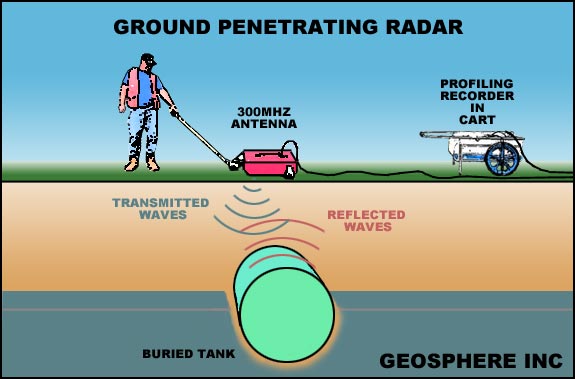Simplified
illustration of the operation of the GSSI SIR-3 radar unit using the 300MHz
antenna
The
radar method determines subsurface conditions by sending pulses of high
frequency electromagnetic waves into the ground from a transmitter antenna
located on the surface. Subsurface structures cause some of the wave energy
to be reflected back to the surface, while the rest of the energy continues
to penetrate deeper. The reflected wave energy is picked up by a receiver
antenna on the surface. These signals are then processed and plotted
in a distance-versus-time display. Thus, as the radar antenna is slowly
towed across the surface, a continuous cross-sectional "picture" of
subsurface conditions is generated. The radar reflections are caused by
wave responses at interfaces of materials having different electrical properties.
These interfaces include many natural conditions such as bedding, cementation,
changes in moisture and clay content, voids, fractures, and intrusions as well
as man-made objects.

Depth
of penetration is dependent on conditions found at each site. Radar
waves are attenuated (absorbed or scattered) by certain properties of the site's
soil, the most important of which is the electrical conductivity of the material.
Generally, better overall penetration is achieved in dry sandy soils; reduced
penetration is achieved in moist, clayey or conductive soils. Considerable
depth may be attained in saturated sands or through lake water if the specific
conductance of the water is low. Radar penetration is excellent in massive
dry materials such as granite, limestone and concrete.
Resolution of radar reflections can be increased by increasing
the frequency of the radar waves transmitted into the ground.
This is done by using one of several different antennas available for the radar
system. However, there is a trade-off between increased resolution and
depth of penetration. In good conditions, the higher frequency (900
and 500 megahertz (MHz)) antennas are capable of penetrating 5 to 15
feet of soil with resolution on the order of 0.5-2 inches, whereas the lower
frequency (300 and 80 MHz) antennas may attain 30 to 80 feet depths
with resolution on the order of 0.5-3 feet.
Depths to buried layers or objects is proportional to the time it takes the
radar pulse to travel from the surface antenna to the target and back again
to the receiver antenna. This time is called two-way travel time and
is dependent on the dielectric properties of the media through which
the radar pulse travels. These dielectric properties are in turn a complex
function of the composition and moisture content of the soil and
rock. In almost all cases, the moisture content has the greatest influence
because water has a very high dielectric value compared to common soils and
rock. The greater the amount of water saturation, the lower the radar
velocity and the lower the object will appear in the radar profile.

email:
consultants@geosphereinc.com
124 north auburn road auburn, mi 48611 tel: (989) 662-6149
fax: (989) 662-7701
copyright ©1990-2007 geosphere inc


![]()


